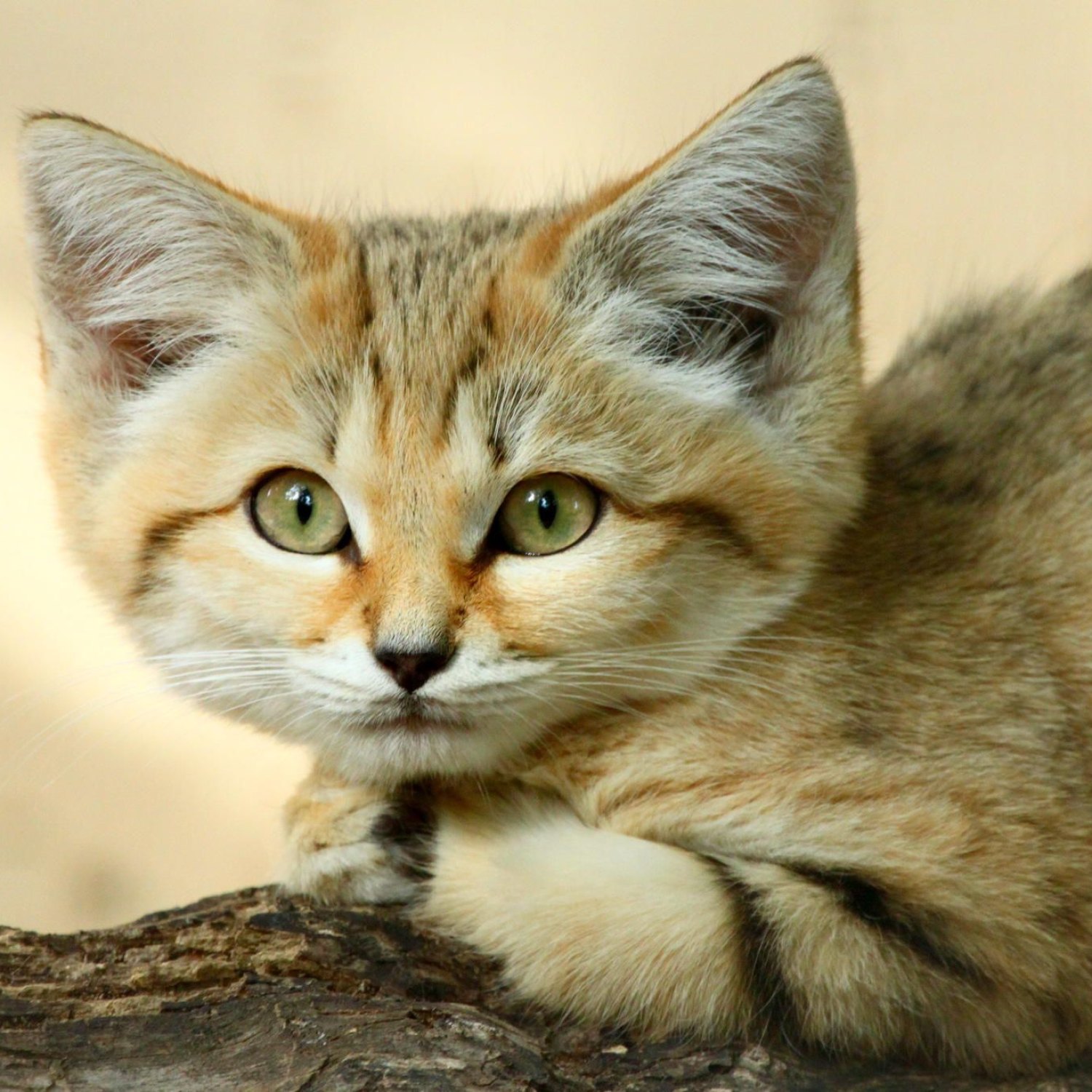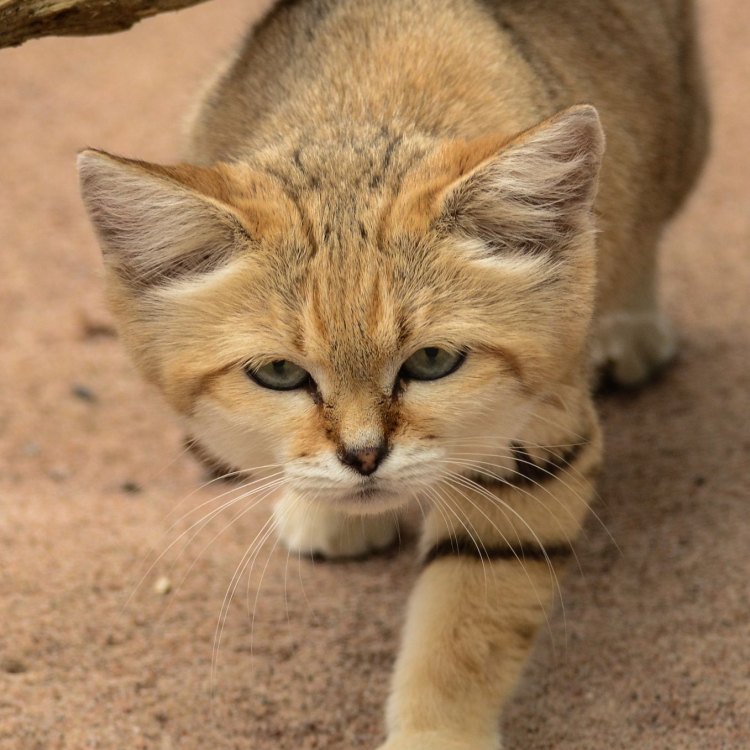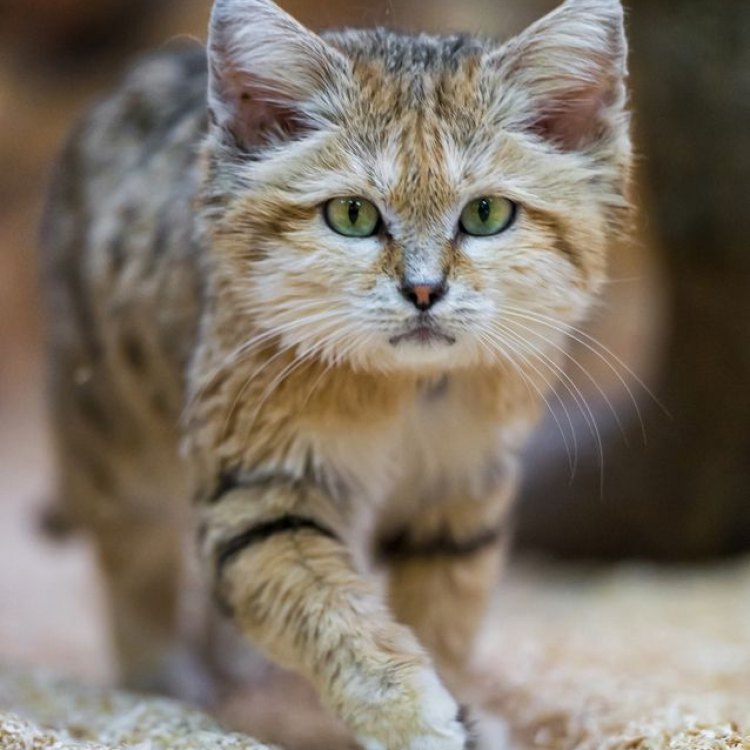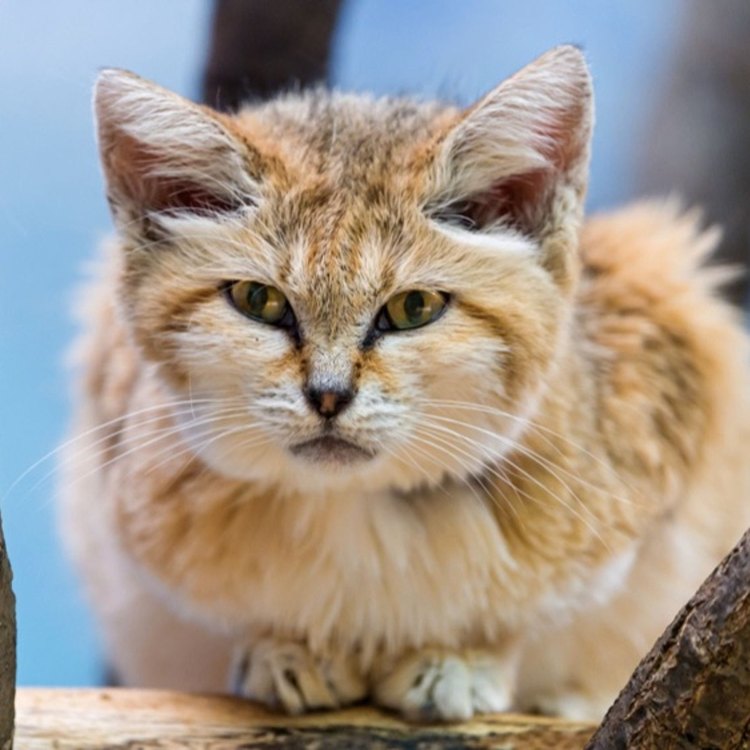
Sand Cat
40-50 centimeters
The Sand Cat, a small and stocky feline, is primarily found in sandy deserts. With a length of 40-50 centimeters, it is the perfect size to navigate through its desert habitat. Belonging to the Felidae family, it is a skilled hunter and can adapt to extreme weather conditions. #SandCat #Feline #DesertHabitat
Animal Details Summary:
Common Name: Sand Cat
Kingdom: Animalia
Habitat: Deserts
The Fascinating World of Sand Cats: A Mysterious Feline of the Desert
The world is full of wonders, both known and unknown. As we continue to explore and learn about our planet, we come across creatures that amaze us with their unique features and adaptations. One such creature is the Sand Cat, also known as Felis margarita. This mysterious feline is a master of survival in the harsh desert environment and its elusive nature has made it a subject of wonder and fascination Sand Cat. In this article, we will delve into the world of Sand Cats and discover what makes them one of the most interesting and enigmatic felines on the planet.A Member of the Felidae Family
The Sand Cat belongs to the Felidae family, which includes all the species of cats. This family is known for its variety of members, from the domesticated house cat to the ferocious lion. The Sand Cat, however, is quite distinct from its relatives. Its scientific name, Felis margarita, is derived from the Greek word "margarita" which means "pearl". This name was given to the Sand Cat due to its pale yellow to sandy gray color, resembling the color of a pearl.A Hardy Species that Thrives in Deserts
Out of all the members of the Felidae family, the Sand Cat has the most specialized adaptations for living in the harsh desert environment. It is primarily found in sandy deserts, such as the Sahara in northern Africa, the Arabian Peninsula, and the deserts of Central Asia. Despite the extreme temperatures and scarcity of resources, the Sand Cat has managed to thrive in these conditions Sailfish. This makes it one of the most unique and resilient cats in the world.A Carnivore with Specialized Feeding Methods
Like most members of the Felidae family, the Sand Cat is a carnivore, meaning it feeds on meat. Its small, stocky body, measuring just 40-50 centimeters in length, is perfectly adapted for hunting small prey. The Sand Cat's main source of food includes rodents, birds, and reptiles. It has also been observed to feed on insects and arachnids, making it a versatile hunter.But what makes the Sand Cat stand out from other carnivorous cats is its specialized feeding methods. Due to the scarcity of water in the desert, the Sand Cat has adapted to get most of its water intake from its food. This is made possible through its highly efficient kidneys, which allow it to extract water from its prey and minimize the need for external water sources.
A Wide Geographical Distribution
The Sand Cat is a well-traveled feline and can be found in multiple countries, from Algeria in the west to India in the east. Some of the countries where it is found include Egypt, Iran, Iraq, Israel, Jordan, Kazakhstan, Kuwait, Libya, Morocco, Niger, Oman, Pakistan, Saudi Arabia, Sudan, Syria, Tunisia, Turkmenistan, United Arab Emirates, Uzbekistan, and Yemen. Its wide geographical distribution is a testament to its ability to adapt and survive in different environments.A Master of Disguise
One of the most striking features of the Sand Cat is its coloration. Its pale yellow to sandy gray fur, which also has stripes and spots, allows it to blend in perfectly with its surroundings. This is essential for survival in the desert, where predators and prey are constantly on the lookout for each other. The Sand Cat's excellent camouflage enables it to not only hunt effectively but also avoid detection from larger predators.But the Sand Cat's camouflage is not just limited to its appearance. It also has thick fur on its paw pads, which not only protect its paws from hot sand but also help it walk silently, making it even harder for prey to detect its presence. This stealthy feline is truly a master of disguise.
An Elusive and Mysterious Feline
Due to their highly secretive and elusive nature, not much is known about Sand Cats. They are primarily nocturnal animals and are rarely seen during the day. This, combined with their excellent camouflage, makes studying them very difficult. Their small size and timid behavior also make them hard to spot in the vast desert landscape.However, this enigmatic feline's mysterious ways have not stopped researchers from trying to learn more about it. Thanks to the development of new technologies and techniques, scientists have been able to gather some information about the behavior and adaptations of Sand Cats. But there is still much that remains to be discovered about this elusive feline.
The Conservation Status of Sand Cats
Despite their unique adaptations and elusive nature, Sand Cats are facing a number of threats that have led to their dwindling population. The biggest threat to their survival is the loss of their natural habitat due to human activities, such as oil and gas drilling, and agricultural expansion. This has caused fragmentation and degradation of their desert homes, making it difficult for them to find food and shelter.Sand Cats are also hunted for their fur, which is used in local crafts and traditional medicine. This, combined with roadkill and accidental trapping, has further contributed to their declining numbers. They are also affected by diseases and parasites, especially in areas where they come into close contact with domestic cats.
Efforts Towards Saving the Sand Cat
The conservation of the Sand Cat is a complex issue that requires efforts from multiple stakeholders. Several organizations, such as the Sand Cat Conservation Project and the Arabian Sand Cat Network, are working towards conserving this rare and elusive feline. These organizations conduct research, raise awareness, and collaborate with local communities and governments to address threats to Sand Cats and their habitats.In addition, there are ongoing efforts to breed Sand Cats in captivity and release them into the wild. The information gathered from studying captive Sand Cats can provide valuable insights into their behavior and help with their conservation in the wild. It is also important to reduce human interference and protect their natural habitats, which are crucial for their survival.
The Enduring Mystery of the Sand Cat
Despite being a well-traveled and widespread species, the Sand Cat remains a creature shrouded in mystery. Its elusive nature, combined with its remarkable adaptations, make it one of the most intriguing members of the Felidae family. Its ability to thrive in the harsh desert environment and remain elusive in the face of human activities only adds to its mystique.As we continue to learn and discover more about this unique feline, it is important to remember the importance of its conservation. The Sand Cat is not just a fascinating creature, but also an integral part of the delicate desert ecosystem. By protecting this enigmatic feline, we are also protecting the fragile balance of the desert and ensuring a better future for all its inhabitants.

Sand Cat
Animal Details Sand Cat - Scientific Name: Felis margarita
- Category: Animals S
- Scientific Name: Felis margarita
- Common Name: Sand Cat
- Kingdom: Animalia
- Phylum: Chordata
- Class: Mammalia
- Order: Carnivora
- Family: Felidae
- Habitat: Deserts
- Feeding Method: Carnivorous
- Geographical Distribution: Northern Africa, Middle East, Central Asia
- Country of Origin: Multiple countries including Algeria, Egypt, Iran, Iraq, Israel, Jordan, Kazakhstan, Kuwait, Libya, Morocco, Niger, Oman, Pakistan, Saudi Arabia, Sudan, Syria, Tunisia, Turkmenistan, United Arab Emirates, Uzbekistan, Yemen
- Location: Primarily found in sandy deserts
- Animal Coloration: Pale yellow to sandy gray
- Body Shape: Small and stocky
- Length: 40-50 centimeters

Sand Cat
- Adult Size: Small to medium-sized
- Average Lifespan: 10-13 years
- Reproduction: Mating occurs throughout the year
- Reproductive Behavior: Females give birth to 2-4 kittens after a gestation period of approximately 59-66 days
- Sound or Call: Produces various vocalizations including a high-pitched call similar to a domestic cat
- Migration Pattern: Non-migratory
- Social Groups: Solitary
- Behavior: Nocturnal and highly adapted to desert life
- Threats: Habitat loss, hunting, trafficking for the illegal pet trade
- Conservation Status: Near Threatened
- Impact on Ecosystem: Helps control rodent populations
- Human Use: Sometimes kept as exotic pets
- Distinctive Features: Large eyes and ears, long legs, fur-covered paws
- Interesting Facts: Can withstand extremely high temperatures in their desert habitat
- Predator: Larger carnivores such as eagles, owls, and snakes

Felis margarita
The Hardy Cat of the Desert: The Sand Cat
Hidden within the vast and harsh desert landscapes, the sand cat, also known as Felis margarita, is a fascinating and resilient feline species. This small to medium-sized cat has adapted to thrive in some of the toughest environments on Earth, making it a true survivor. In this article, we will dive into the unique characteristics and habits of the elusive sand cat – from its reproduction behavior to its impact on the ecosystem.Size and Lifespan
Sand cats are relatively small in size, measuring between 17-22 inches in length and weighing around 4-8 pounds as adults PeaceOfAnimals.Com. Despite their compact size, they have powerful legs that allow them to run up to 30 miles per hour to chase their prey. As for their lifespan, sand cats can live up to 10-13 years in captivity and slightly less in the wild.Reproduction Behavior
One of the most remarkable aspects of sand cat’s reproduction behavior is that they can mate throughout the year. This is a unique trait for most feline species, as they usually have particular breeding seasons. Female sand cats will give birth to 2-4 kittens after a gestation period of approximately 59-66 days. The kittens are born blind and helpless, and the mother will nurse and care for them for about 5 months until they are ready to leave her.Sounds and Calls
The sand cat may be small in size, but it has a wide range of vocalizations that they use for communication. They produce a high-pitched call similar to a domestic cat, but their vocalizations also include growls, snarls, and hisses. They use these sounds to communicate with other sand cats, especially during mating season Sardines. Interestingly, male sand cats are known to make a unique “bleating” sound to attract females during mating.Social Groups and Behavior
Unlike most feline species, sand cats are solitary animals, and they prefer to live and hunt alone. However, they do not have strict territories and may occasionally share the same area with other sand cats. They are also known to be nocturnal creatures, which means they are most active during the night. This behavior helps them avoid the intense heat of the desert during the day.Threats and Conservation Status
As with many other species, the sand cat is facing various threats, including habitat loss, hunting, and trafficking for the illegal pet trade. Due to their elusive nature, it is challenging to determine their population size accurately. However, the International Union for Conservation of Nature (IUCN) has listed sand cats as “Near Threatened” on the Red List of Threatened Species, and their numbers continue to decline.Impact on the Ecosystem
Despite their small size, sand cats play a significant role in preserving the delicate balance of the ecosystem in which they live. As opportunistic predators, sand cats mainly feed on small rodents such as gerbils and jerboas. By controlling the rodent population, they help maintain the health of the plants and other animals in their habitat. They also serve as prey for larger carnivores, including eagles, owls, and snakes.Human Use and Distinctive Features
Unfortunately, sand cats are sometimes kept as exotic pets, contributing to the decline of their population in the wild. In some countries, they are also hunted for their fur and body parts, which are used in traditional medicine. However, sand cats have unique features that make them well-suited for their desert environment. These include large, oval-shaped eyes and large ears, which help them detect prey and stay cool in the extreme heat. Their fur-covered paws also protect them from the hot sand while hunting.Interesting Facts
Beyond their distinctive features and behavior, there are many fascinating facts about sand cats that make them even more intriguing. For example, sand cats are incredibly resilient creatures and can survive in temperatures as high as 158 degrees Fahrenheit. They are also excellent diggers, using their powerful paws to create burrows in the sand to keep cool during the day.The Future of the Sand Cat
As a species that is highly adapted to its environment, it is crucial to protect and conserve the sand cat. Organizations such as the Sand Cat Sahara Conservation Initiative and the Global Sand Cat Conservation Program are working towards protecting the species and their habitats. Through research and community education, these efforts aim to raise awareness and support for the conservation of the sand cat and its ecosystem.In conclusion, the sand cat is a truly remarkable and resilient species, adapted to survive in the harshest of conditions. As one of the least studied felines, there is much to learn and appreciate about this elusive creature. Let us continue to admire these beautiful cats from afar and take actions to ensure their survival in the wild. After all, the survival of the sand cat reflects the health and diversity of the delicate desert ecosystem they call home. Meow-Meow!

The Fascinating World of Sand Cats: A Mysterious Feline of the Desert
Disclaimer: The content provided is for informational purposes only. We cannot guarantee the accuracy of the information on this page 100%. All information provided here may change without prior notice.












